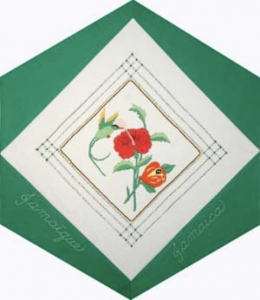Jamaica

The Block
On a linen background, Marjorie Blake’s drawn-thread work creates a distinctive border around the Jamaica block. Jamaicans typically do their embroidery on this type of fabric, reflecting a connection to both England and Ireland. The central images are embroidered in a variety of stitches, including crewel, long and short, and satin. The Swallowtail Humming Bird featured on this block, also known as The Doctor Bird, exists only in Jamaica and has been immortalized in Jamaican folklore and song for decades. The beautiful hibiscus which grows wild and is also cultivated and can be found in homes and gardens. Next to the flower is an ackee, the national fruit of Jamaica. Many islands grow ackee as an ornamental tree, but only Jamaicans consume its fruit. Narrow bands of thread, in two of the country’s national colours, black and gold, frame the inner design.
Cultural Profile
Jamaica was described by Columbus as “the fairest isle that eyes beheld; mountainous… all full of valleys and fields and plains”. It is the third largest island in the Caribbean, renowned for spectacular waterfalls and scenery, underground caves and Green Grotto Lake. It grows much of the world’s supply of allspice, ground from the Jamaican pimento. English is the official language although many Jamaicans speak Jamaican patois, a constantly evolving language that reflects the vitality of Jamaican culture and its strong African heritage.
A truly multi-racial society, Jamaica’s national motto is “Out of Many, One People.” Marriage is less common here than in other countries and most families are headed by women. Traditionally, neighbours, teachers and other family members all participate in the task of bringing up ‘the community’s children.’
Jamaica’s mountainous interior has fostered the development of the unique culture of the Maroons. During the 17th and 18th century many West Africans, brought into island as slaves, escaped into the eastern interior region and created free communities. These people fiercely defended themselves against Spanish invaders and later, British armies, to preserve their independence. They eventually gained control over large areas of the island and the various African cultural elements merged over time to produce what is known today as the Maroon culture.
Jamaica is well-known for its music, which is a central part of Jamaican life. Ska originated here in the 1950s. An amalgamation of calypso, jazz and rhythm and blues, it remains very popular. Reggae, a blend of Afro-American rhythms and modern instruments, dominated the international music scene in the 1970s and is still prevalent today. The country is also known for its wood-carving, black coral jewelry, basketry, woven hats and mats, coconut carving, folk lore and riddle telling.
Another well-known cultural export of the country is its cuisine. As Jamaicans began emigrating from the island starting in the 1940s, they took with them their distinctive dishes such as Jamaican patties, jerk chicken, goat curry, ackee and salt fish.
Jamaicans excel in track and field, holding many of the world records in running. Children begin training in school programs at an early age and compete annually in national track meets. Winners are treated as heroes in this small nation.
Jamaicans arrived in Canada as early as 1776 and were instrumental in building the Halifax Citadel. In the early 20th century, they helped fill the demand for railway porters, domestics and blacksmiths. Today there are over 400,000 Jamaicans living in Canada in all walks of economic life. They have formed many organizations for social, cultural and educational purposes, including the Jamaican Canadian Association, the Council of Jamaicans and the National Council of Jamaicans and Supportive Organizations.
Sponsor: Royal Canadian Legion, Branch 297
